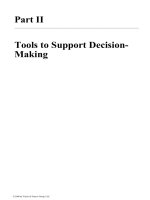Financial accounting 8e tool for busniess decision making chapter 06
Bạn đang xem bản rút gọn của tài liệu. Xem và tải ngay bản đầy đủ của tài liệu tại đây (3.34 MB, 69 trang )
6-1
6
Reporting and Analyzing Inventory
Kimmel ● Weygandt ● Kieso
Financial Accounting, Eighth Edition
6-2
CHAPTER OUTLINE
LEARNING OBJECTIVES
1
6-3
Discuss how to classify and determine
inventory.
2
Apply inventory cost flow methods and discuss their financial effects.
3
Explain the statement presentation and analysis of inventory.
LEARNING OBJECTIVE
1
Discuss how to classify and determine inventory.
Merchandising Company
One Classification:
Merchandise Inventory
▼ HELPFUL HINT Regardless of the classification,
Manufacturing Company
Three Classifications:
Raw Materials
Work in Process
Finished Goods
companies report all inventories under Current Assets
on the balance sheet.
6-4
LO 1
ACCOUNTING ACROSS THE ORGANIZATION
A Big Hiccup
JIT can save a company a lot of money, but it isn’t without risk. An unexpected disruption in the supply chain can cost a company
a lot of money. Japanese automakers experienced just such a disruption when a 6.8-magnitude earthquake caused major
damage to the company that produces 50% of their piston rings. The rings themselves cost only $1.50, but you cannot make a
car without them. As a result, the automakers were forced to shut down production for a few days—a loss of tens of thousands of
cars. Similarly, a major snowstorm halted production at the Canadian plants of Ford. A Ford spokesperson said, “Because the
plants run with just-in-time inventory, we don’t have large stockpiles of parts sitting around. When you have a somewhat
significant disruption, you can pretty quickly run out of parts.”
Sources: Amy Chozick, “A Key Strategy of Japan’s Car Makers Backfires,” Wall Street Journal (July 20, 2007); and Kate Linebaugh, “Canada Military
Evacuates Motorists Stranded by Snow,” Wall Street Journal (December 15, 2010).
6-5
LO 1
DETERMINING INVENTORY QUANTITIES
Physical Inventory taken for two reasons:
Perpetual System
1.
Check accuracy of inventory records.
2.
Determine amount of inventory lost due to wasted raw materials, shoplifting, or employee theft.
Periodic System
6-6
3.
Determine the inventory on hand.
4.
Determine the cost of goods sold for the period.
LO 1
Taking a Physical Inventory
Involves counting, weighing, or measuring each kind of inventory on hand.
Taken,
6-7
when the business is closed or business is slow.
at the end of the accounting period.
LO 1
ETHICS INSIGHT
Leslie Fay
Falsifying Inventory to Boost Income
Managers at women’s apparel maker Leslie Fay were convicted of falsifying inventory records to boost net
income in an attempt to increase management bonuses. In another case, executives at Craig Consumer
Electronics were accused of defrauding lenders by manipulating inventory records. The indictment said
the company classified “defective goods as new or refurbished” and claimed that it owned certain
shipments “from overseas suppliers” when, in fact, Craig either did not own the shipments or the shipments
did not exist.
6-8
LO 1
Determining Ownership of Goods
GOODS IN TRANSIT
Purchased goods not yet received.
Sold goods not yet delivered.
Goods in transit should be included in the inventory of the company that has legal title to the goods.
Legal title is determined by the terms of sale.
6-9
LO 1
Determining Ownership of Goods
ILLUSTRATION 6-2
Terms of sale
Ownership of the goods passes to the buyer
Ownership of the goods remains with the seller
when the public carrier accepts the goods from
until the goods reach the buyer.
the seller.
Freight costs incurred by the seller are an operating expense.
6-10
LO 1
Determining Ownership of Goods
Review Question
Goods in transit should be included in the inventory of the buyer when the:
6-11
a.
public carrier accepts the goods from the seller.
b.
goods reach the buyer.
c.
terms of sale are FOB destination.
d.
terms of sale are FOB shipping point.
LO 1
Determining Ownership of Goods
Consigned Goods
To hold the goods of other parties and try to sell the goods for them for a fee, but without taking
ownership of the goods.
Many car, boat, and antique dealers sell goods on consignment. Why?
6-12
LO 1
$
6-13
LO 1
DO IT!
1
Rules of Ownership
Hasbeen Company completed its inventory count. It arrived at a total inventory value of $200,000. You have been given the information listed
below. Discuss how this information affects the reported cost of inventory.
1.
Hasbeen included in the inventory goods held on consignment for Falls Co., costing $15,000.
2.
The company did not include in the count purchased goods of $10,000, which
were in transit (terms: FOB shipping point).
3.
The company did not include in the count inventory that had been sold with a
cost of $12,000, which was in transit (terms: FOB
shipping point).
Solution
1.
Goods of $15,000 held on consignment should be deducted from the inventory
count.
2.
The goods of $10,000 purchased FOB shipping point should be added to the
inventory count.
3.
Item 3 was treated correctly.
Inventory should be $195,000 ($200,000 - $15,000 +
$10,000).
6-14
LO 1
LEARNING OBJECTIVE
2
Apply inventory cost flow methods and discuss their financial
effects.
Inventory is accounted for at cost.
Cost includes all expenditures necessary to acquire goods and place them in a condition ready for
sale.
Unit costs are applied to quantities to determine the total cost of the inventory and the cost of
goods sold using the following costing methods:
►
Specific identification
►
First-in, first-out (FIFO)
►
Last-in, first-out (LIFO)
Cost Flow Assumptions
►
6-15
Average-cost
LO 2
SPECIFIC IDENTIFICATION
Illustration: Crivitz TV Company purchases three identical 50-inch TVs on different dates at costs of
$700, $750, and $800. During the year Crivitz sold two sets at $1,200 each. These facts are
summarized below.
ILLUSTRATION 6-3
Data for inventory costing example
6-16
LO 2
SPECIFIC IDENTIFICATION
If Crivitz sold the TVs it purchased on February 3 and May 22, then its cost of goods sold is $1,500 ($700
+ $800), and its ending inventory is $750.
ILLUSTRATION 6-4
Specific identification method
6-17
LO 2
SPECIFIC IDENTIFICATION
Actual physical flow costing method in which items still in inventory are specifically costed to arrive
at the total cost of the ending inventory.
6-18
Practice is relatively rare.
Most companies make assumptions (cost flow assumptions) about which units were sold.
LO 2
COST FLOW ASSUMPTIONS
Cost flow assumption does not need to
be consistent with the physical
movement of goods
Illustration 6-12
Use of cost flow methods in major U.S.
companies
6-19
LO 2
COST FLOW ASSUMPTIONS
Illustration: Data for Houston Electronics’ Astro condensers.
ILLUSTRATION 6-5
Data for Houston Electronics
(Beginning Inventory + Purchases) - Ending Inventory = Cost of Goods Sold
6-20
LO 2
First-In, First-Out (FIFO)
Costs of the earliest goods purchased are the first to be recognized in determining cost
of goods sold.
Often parallels actual physical flow of merchandise.
Companies determine the cost of the ending inventory by taking the unit cost of the most
recent purchase and working backward until all units of inventory have been costed.
6-21
LO 2
First-In, First-Out (FIFO)
ILLUSTRATION 6-6
Allocation of costs—FIFO method
6-22
LO 2
First-In, First-Out (FIFO)
▼ HELPFUL HINT
Another way of thinking about the calculation of FIFO
ending inventory is the LISH assumption—last in still
here.
6-23
LO 2
Last-In, First-Out (LIFO)
Costs of the latest goods purchased are the first to be recognized in determining cost of
goods sold.
6-24
Seldom coincides with actual physical flow of merchandise.
Exceptions include goods stored in piles, such as coal or hay.
LO 2
Last-In, First-Out (LIFO)
ILLUSTRATION 6-8
6-25
Allocation of costs—LIFO method
LO 2









